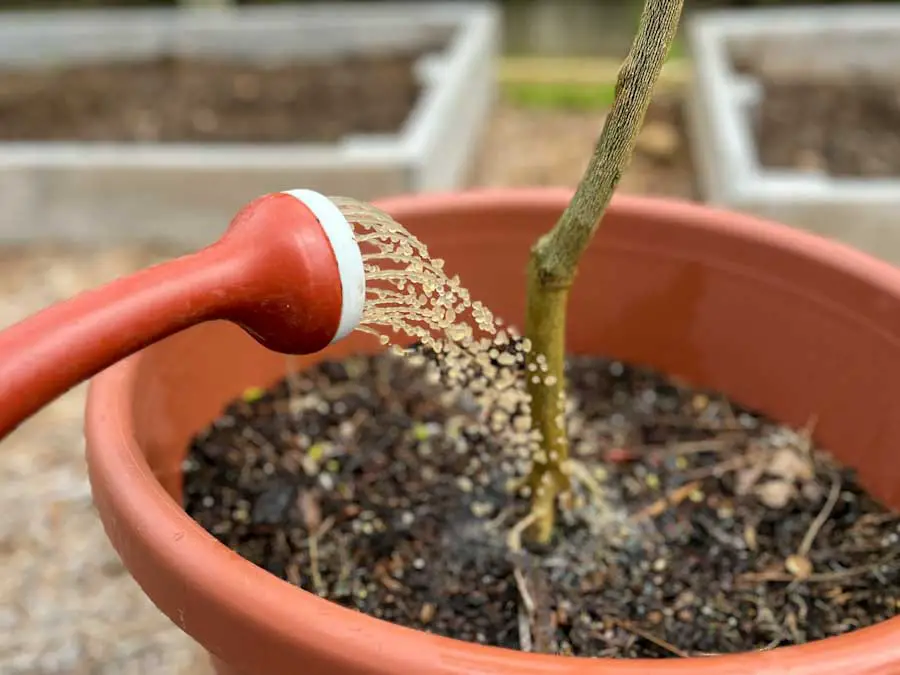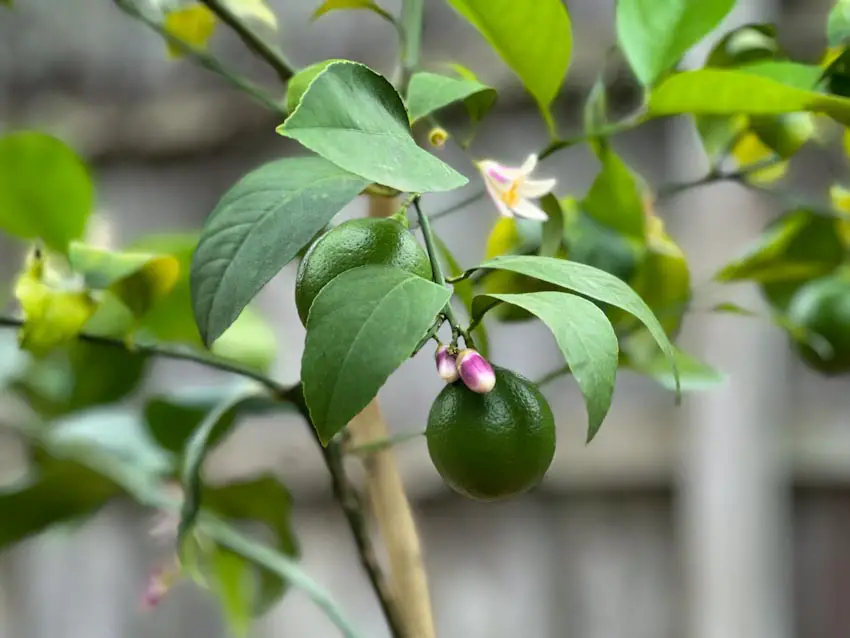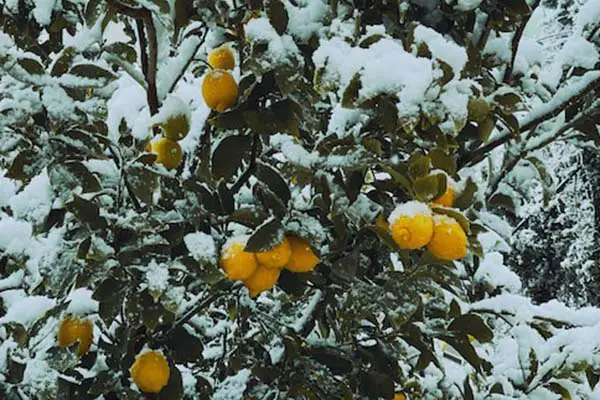
We may receive commissions from purchases made through links in this post, at no additional cost to you.
There are so many advantages to growing lemon trees in containers. For one, for those of us not living in a lemon tree’s native humid, subtropical climate, you can just pick them up and bring them inside for the winter. Potted lemon trees can also grow a ton of fruit in a compact space.
There are so many fun varieties you can grow. I currently have dwarf Improved Meyer and Pink Variegated lemon trees, and there is little that brings me more pleasure than picking my own lemons and using them in drinks and recipes. (And yes, the homegrown ones taste FAR better than what you find at the grocery store.)
In general, potted lemon trees are easy to care for. But the one chore you cannot skip is fertilizing. Lemons are greedy feeders, and since the contained roots can’t sprawl out to get the nutrients they need, that means you – the gardener – have to provide them. So how do you go about fertilizing lemon trees in containers?
For potted lemon trees, the ideal fertilizer is one with a 5-1-3 NPK ratio, or with 2 to 3 times as much nitrogen as the other elements (2-1-1 or 3-1-1). Combine the use of a soluble fertilizer, fish emulsion, and organic slow release granular fertilizer, applied regularly through the growing season.
Container-grown lemon trees may need some extra feeding to fruit their best, but once you understand what they need, it’s simple. We’ll look at what a potted lemon tree’s nutrient needs are, when to feed them, and what kinds of fertilizers to use. A little bit of care and attention and you’ll have more lemons than you know what to do with (if that’s even possible!).
What nutrients do lemon trees need to fruit well?

Lemon Tree Nutrient Needs
Every plant needs a particular combination of macronutrients (nitrogen, phosphorus, potassium, calcium, magnesium, and sulfur) and micronutrients (nickel, iron, zinc, copper, boron, manganese, molybdenum, and chlorine) to thrive. Just like our bodies utilize different nutrients – such as fats, proteins, and carbohydrates – for different functions, plants do the same.
Citrus trees break some of the “rules” (if there are any) when it comes to nutrient needs. Most fruit trees require a balance of nitrogen, phosphorus, and potassium (the NPK on a fertilizer label), as well as other trace elements, to grow and fruit their best.
An excess of nitrogen, in particular, can cause many fruit trees to produce overly vigorous leafy growth, and therefore fewer blossoms and fruit. Phosphorus is the element that tends to promote fruiting and blossoming, and potassium is good for overall cellular growth and plant health.
But citrus trees, especially lemons, need far more nitrogen than most other fruit trees. In the case of citrus trees, it is nitrogen that has a bigger effect on not only overall growth, but fruit production. The amount of nitrogen affects how well the tree can absorb the other elements it needs (source).

Lemons and other citrus also need a comparatively large amount of potassium, as it greatly enhances fruit size, color and flavor. The right concentration of potassium can also help the tree be more resilient to drought, overwatering, and temperature stress.
Lemon Tree Fertilizer NPK Ratio
Ideally, look for a lemon tree fertilizer with an NPK ratio of about 5-1-3 (5% nitrogen, 1% phosphorus, 3% potassium). It can be a challenge to find these exact ratios, as many citrus fertilizers are formulated to be suited to a variety of different plants.
Another good rule of thumb is to look for a fertilizer that has about 2 to 3 times the nitrogen to the other elements (so, a ratio of 2-1-1 or 3-1-1). Any of these ratios will work well for lemon trees.
Potted Lemon Tree Fertilizer: Look for an NPK ratio of about 5-1-3, or two to three times the nitrogen to phosphorus and potassium (2-1-1 or 3-1-1).
In addition to the NPK ratio, pay attention to the trace micronutrients in the fertilizer you choose. I prefer organic fertilizers for this reason – they are derived from natural ingredients, which means they typically also include a variety of micronutrients that the plant can absorb.
Synthetic fertilizers only contain the elements that the manufacturer has decided to include in the formula. There are sometimes reasons to use synthetic fertilizers (for one, they come in higher concentrations), but I like to stick to organic as much as possible.
Side note: We passionate gardeners sometimes like to “get into the weeds” (sorry for the pun) when it comes to exact fertilizer ratios and nutrient requirements. But, it’s worth noting that the plant will absorb what it needs from what’s available. A balanced NPK fertilizer, such as 8-8-8, will still benefit your lemon tree.
I’m providing the info on what is ideal for a potted lemon tree, but you don’t need get too hung up on the exact ratio of elements in your fertilizer! As long as the plant is thriving and fruiting well, it’s getting what it needs. Just make sure to feed the lemon tree regularly, and it will absorb the nutrients it requires.
Soluble vs. Slow-Release Fertilizer
For in-ground lemon trees, it’s best to use a slow release, granular fertilizer. These fertilizers need to be broken down over time by the microorganisms in the soil in order to be absorbed by the roots of the tree.

But for potted lemons, there is far less soil present in the container, which means fewer microorganisms to break down fertilizer ingredients. This is why it’s essential to also use some liquid, soluble fertilizer for your potted lemon trees. The liquid formulas are able to be immediately absorbed and used by the plant.
When to Fertilize Lemon Trees in Containers
The general recommendation for in-ground lemon trees is to calculate the amount of fertilizer a tree needs over the course of a year (determined by the tree’s size and age and the results of soil tests), divide into three or four doses, and apply in intervals throughout the year.
But with potted lemon trees, many of the nutrients provided by fertilizers will be flushed out by frequent watering. So it’s more important to provide regular, relatively frequent doses of fertilizer throughout the growing season.
Feeding Potted Lemons Throughout the Year
In general, begin fertilizing container-grown lemon trees in the late winter or early spring, just before the tree begins to blossom. Continue to fertilize in 2- to 4-week intervals throughout the spring and summer. Stop fertilizing in fall as the weather turns cooler and the tree’s growth slows.

In most climates, lemon trees will go semi-dormant in the winter. They don’t lose their leaves, but they will slow their growth significantly during the cooler months. Your potted lemon tree may need to be brought into the house, garage, or shed for protection once the weather turns cold.
Because of the semi-dormancy, it’s best not to fertilize a potted lemon tree during the winter months. The tree doesn’t need additional nutrients to sustain any growth during this time, and it even needs minimal watering (just enough to keep the roots from drying out). At most, you can feed once or twice over the winter with a diluted fish fertilizer, especially if you have a particularly long winter season.
But once the weather begins to warm in early spring, it’s time to start feeding the tree regularly. As the tree blossoms, fruits, and grows throughout the summer, continue the fertilizing regimen. Once fall hits, you may notice the tree’s growth start to slow down. This is a cue to stop fertilizing the tree so it can wind down for the winter.
An exception is for those in climates where the lemon tree can stay outdoors year round (typically in USDA zones 9-11). Certain lemon trees, such as Improved Meyer, may continue producing blossoms and fruit all throughout the year in warm climates. In that case, I would continue fertilizing throughout the winter, although perhaps a little less frequently.

In my zone 8b Texas climate, I generally give the last dose of fertilizer around Thanksgiving, since that’s when the weather begins getting significantly cooler. In more northern areas, the last feeding may be in September or October.
I can typically leave my potted citrus trees outside until Christmas or New Year’s unless we have a heavy frost predicted. I then keep the plants in the garage through January and most of February, then start gradually reintroducing them as the weather warms in early March.
My first fertilizing in the spring is usually between Valentine’s day and the first of March. Again, this will likely be later in colder climates…maybe closer to St. Patrick’s day or April Fool’s if we’re going by holidays.
How often should you feed potted lemon trees?
The frequency of fertilizing potted lemons is largely determined by how often you need to water them. As the summer heats up, I often have to water my trees once or even twice a day. We also tend to get very heavy rains throughout the spring. I’ve found that in my climate, it’s best to feed my potted lemon trees every 2 to 3 weeks.
If you live in a drier climate, such as parts of California or Arizona, or an area with less extreme summer heat, a 4-week fertilizing schedule will work well. In general, if you have to water your tree a little less frequently, then the nutrients won’t leach out of the soil as quickly, and you don’t have to replace them as often.
FRUIT GROVE TIP: Set up calendar reminders on your phone according to your fertilizing schedule! That way you never miss a feeding.
Do a little experimenting to figure out what fertilizing schedule works best for your trees and your climate. Also take into consideration the size and age of the tree. If you have a mature lemon tree in a very large pot or half whiskey barrel, you may need to fertilize more often. As a rule, most potted lemon trees need feeding every two to four weeks.
An exception may be plants that live inside the house year-round. Since an indoor tree is exposed to less extremes of heat and sun, you probably don’t need to water it as often. Fertilizing every four to six weeks may be enough.
When NOT to Fertilize Potted Lemon Trees
When the tree is first planted. Avoid adding any fertilizers when you first pot up your lemon tree. Many potting soils already contain some fertilizer, so adding more may do more harm than good. Give it a chance to adjust to its new environment, water it well, and fertilize it for the first time a few weeks later.
When the tree is stressed. Sudden temperature fluctuations, drought, overwatering, disease, or pests can cause problems for a lemon tree, such as yellowing, drooping, or falling leaves, or premature fruit drop. Fertilizing an already stressed-out tree could cause it even more issues, or even death.
Take steps to correct the source of stress – adjust the watering schedule, find a new location for the tree, or treat the pest and disease problems – before fertilizing. Once the tree seems on the way to recovery, get back to your regular fertilizing schedule.

During winter semi-dormancy. As we talked about above, lemon trees drastically slow their growth during the winter in most climates. There is no need to fertilize during the months when the tree is essentially not growing.
Fertilizing in winter may trick the plant into beginning to grow again too soon, which may actually decrease the following year’s crop since the tree won’t have saved up the energy it needs to produce a flush of blossoms in spring. The exception is for those in warm climates that can keep their trees outside year round – in that case, continue fertilizing throughout the year.
Fertilizing Plan/Schedule for Potted Lemon Trees
Here’s what I do to keep my potted lemon trees happy, healthy, and fruiting prolifically:
Every two to four weeks, apply the following combination:
Soluble (liquid), preferably organic fertilizer. With potted fruit trees (and potted plants in general), it’s essential to use soluble fertilizers so the roots can access nutrients immediately. Soluble fertilizers don’t need to be broken down by the microorganisms in the soil in order to be absorbed by the plant.

Lately I’ve been using the Miracle-Gro Performance Organics All Purpose Fertilizer. Its 11-3-8 NPK ratio is pretty close to the recommended 5-1-3 for lemon trees. It also contains calcium, copper, iron, manganese and zinc. Apply according to the package instructions.
You can use just about any soluble fertilizer. I would stay away from anything with a very high NPK concentration, such as 24-8-16, to avoid burning the tree. If you use a stronger fertilizer, water it down to make it weaker.
Fish emulsion. Fish emulsion is another good source of nitrogen, but it also provides many micronutrients and organic material that actually feeds the microbiome in the soil. There’s not much soil present in a potted tree’s container, so anything you can do to enhance soil health is beneficial.
Most fish or kelp fertilizers have a 5-1-1 NPK ratio, including this Alaska Fish Fertilizer that I commonly use. I add about 2-3 tablespoons (a good glug from the bottle) to the same 1.5-gallon watering can.
Organic, granular, slow-release fertilizer. I also feed my potted lemons with a slow-release fertilizer, which will break down over time as I continue to water the tree. You can use one that’s formulated especially for citrus (see below for some specific recommendations), or any all-purpose or tomato fertilizer that has a higher ratio of nitrogen to the other elements (5-1-3, 2-1-1, or 3-1-1).

I’ve used several different granular fertilizers for my lemon trees, but lately I’ve been happy with the Espoma Citrus-tone Citrus and Avocado Food. It has a 5-2-6 NPK ratio, it’s inexpensive, and it’s readily available at big-box stores. It also makes a good all-around fertilizer for most fruit trees.
Sprinkle a couple of tablespoons around the base of the tree (at least a few inches away from the trunk). Water it in using the liquid fertilizers and water mixture in the watering can.
Fruit Grove Tip: Don’t have the right fertilizer for your lemon tree? Use any organic all-purpose or tomato fertilizer and add blood meal (usually 12-0-0) to increase the nitrogen content. Follow the package instructions to add the right amount to increase the ratio of nitrogen in your fertilizer.
The Fruit Grove Recommended Lemon Tree Fertilizers
Liquid Fertilizers:
Miracle-Gro Performance Organics All-Purpose Fertilizer
This is inexpensive, readily available, and has a good nutrient breakdown for lemon trees (11-3-8, plus micronutrients).
Alaska Fish Fertilizer
Any fish-based emulsion will do the job, but this is the one I most often use. It has a 5-1-1 NPK ratio, and it provides organic matter that enhances soil and plant health.
Granular Fertilizers:
Espoma Citrus-tone Citrus and Avocado Food
This is an inexpensive, easy-to-find organic fertilizer with a 5-2-6 ratio, plus calcium, magnesium, sulfur, and other micronutrients.
Fox Farm Happy Frog Organic Citrus and Avocado Fertilizer
This is the priciest option on the list, but I have always found Fox Farm products to be very high quality. It has a 7-3-3 NPK ratio (perfect for lemon trees). It also includes calcium, sulfur, and mycorrhizal fungi to enhance root health and nutrient absorption.
Dr. Earth Sweet & Sour Citrus Fertilizer
This 6-3-3 fertilizer has the perfect balance of nutrients for lemon trees. It also includes their proprietary “TruBiotic” blend of mycorrhizae and beneficial microbes to help break down organic matter and enhance nutrient absorption.

